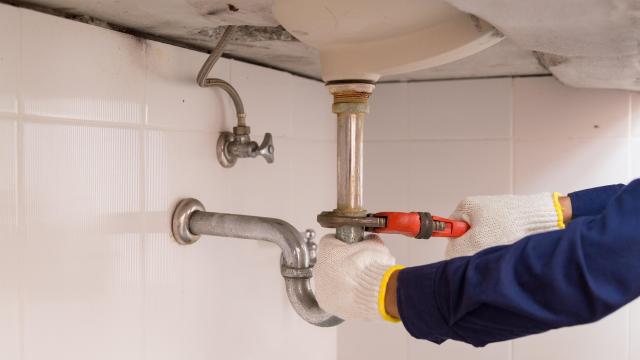If you’ve ever spent any real time perusing your local hardware store, you have probably seen something called Plumber’s Putty on the shelves. Or maybe you hired a plumber to do some work and you spotted it among their tools and materials: It’s typically a compound with a base of clay or dough, combined with some other material (often an oil) to give it elasticity that is used to create watertight seals that remain soft and pliable for a long time. It’s actually very useful stuff to have around: It’s cheap, lasts a long time when properly stored, and comes in handy in a lot of scenarios.
Sealing fixtures
First and foremost, plumber’s putty’s primary use is to seal plumbing fixtures like drains or faucets to a surface (a countertop or sink). If you wake up one day and discover your kitchen sink drain has started to leak, it’s actually super easy to fix with a tub of plumber’s putty and a wrench instead of paying an expensive plumber bill. Here’s how:
- Remove drain by unscrewing the nut underneath
- Clean area thoroughly
- Take a golf ball-sized amount of plumber’s putty and work it into a thin roll
- Place putty around circumference of the drain
- Push drain back into place, secure, and clean off excess putty
That’s it! Plumber’s putty works by forming a barrier that water can’t permeate. It can’t handle high water pressure, but low pressure stuff like steady leaks is right in its wheelbarrow. You can use plumber’s putty to seal out water around most plumbing fixtures like faucets, kitchen and bathroom sink drains, and shower drains.
The big advantage over caulk is that you can easily remove the fixture later. Caulk hardens and adheres, complicating the process. Plus, you can use your drain or faucet immediately when using plumber’s putty — no need to wait for it to set up or dry.
Note that often, when you buy a new drain or faucet kit, the manufacturer will provide a gasket that obviates the need for plumber’s putty. These usually work just fine, but it’s still a good idea to have some putty on hand in case the gasket fails at some point.
Joining pipes
You can use plumber’s putty instead of Teflon tape if you’re connecting two pipes. Just apply the putty to the inside threads and then connect your pipes, wiping away the excess.
Again, this will work well with low-pressure fittings, but if your pipes are going to have high water pressure you’ll do much better with Teflon tape. But if you need to make an emergency repair and don’t have any tape, plumber’s putty will likely be good enough for a temporary fix until you can get to a hardware store or get a professional in for a repair.
Sealing a toilet
Your toilet should be sealed to the floor — and contrary to a lot of misinformation out there, your toilet should be sealed all the way around. Anyone who tells you to leave a gap so you know if there’s a water leak is, simply, wrong.
A toilet should also be sealed using caulk, because one of the functions of sealing your toilet to the floor is to reduce any chance of movement. Since caulk adheres, it helps to stabilise your toilet while also blocking smells and leaks. If you’re installing a toilet, however, you can use plumber’s putty to create an initial waterproof seal between the toilet and the floor, and then caulk over it. You can also use plumber’s putty around the wax ring that seals the toilet to the flange in the floor. This will prevent the wax from getting stuck on the toilet, which will make removing it a breeze when the time comes. Future You or the next owner of your home will thank you.
Plumber’s putty has a pretty narrow niche of applications, but within that niche it’s super useful. Having a small tub of this stuff around will come in handy any time you have a leaking fixture in your kitchen or bathroom. Plus, it’s kind of fun to play with.

Leave a Reply
You must be logged in to post a comment.